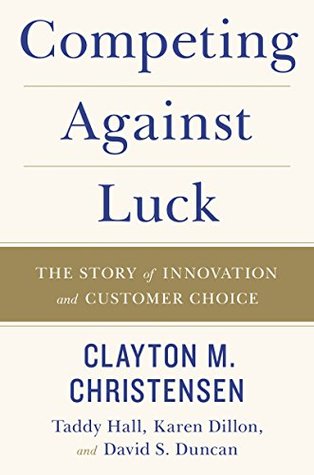More on this book
Community
Kindle Notes & Highlights
But that doesn’t have to be the case, not when you truly understand what causes consumers to make the choices they do.
Innovation can be far more predictable—and far more profitable—but only if you think about it
differ...
This highlight has been truncated due to consecutive passage length restrictions.
It’s about progress, not...
This highlight has been truncated due to consecutive passage length restrictions.
poll,
percent of global executives acknowledged that innovation is
important to their growth strategies, yet a staggering 94 percent were unsatisfied with their...
This highlight has been truncated due to consecutive passage length restrictions.
But for most of them, innovation is still painfully hit or miss.
And worst of all, all this activity gives the illusion of progress, without actually causing it.
As Yogi Berra famously observed: “We’re lost, but we’re making good time!”
Here is the fundamental problem: the masses and masses of data that companies accumulate are not organized in a way that enables them to reliably predict which ideas will succeed.
Nate Silver,
The Signal and the Noise: Why So Many Predictions Fail—But Some Don’t, points out, “ice cream sales and forest fires are correlated because both occur more often in the summer heat.
But there is no c...
This highlight has been truncated due to consecutive passage length restrictions.
Of course, it’s no surprise that correlation isn’t the same as causality.
But correlation does not reveal the one thing that matters most in innovation—the causality behind why I might purchase a particular solution.
Edwards Deming,
“If you do not know how to ask the right question, you discover nothing.”
After decades of watching great companies fail over and over again, I’ve come to the conclusion that there is, i...
This highlight has been truncated due to consecutive passage length restrictions.
What job did you hire that pr...
This highlight has been truncated due to consecutive passage length restrictions.
When we buy a product, we essentially “hire” something ...
This highlight has been truncated due to consecutive passage length restrictions.
core insight
Who would have imagined that a service that makes travelers pay to stay in a stranger’s spare bedroom would be valued at more than Marriott, Starwood, or Wyndham Worldwide?
Airbnb did it.
When you have a job to be done and there isn’t a good solution, “cheaper and crappier” is better than nothing.
It’s about something much more important to you
creating and predicting new ones.
Theory of Jobs to...
This highlight has been truncated due to consecutive passage length restrictions.
Jobs Theory5, we believe, can move companies beyond hoping that correlation is enough to the causal mechanism of successful innovation.
“Marketing Malpractice”
How Will You Measure Your Life?
There is a better question to ask—one that can help us understand the causality underlying a customer’s decision to pull a new product into his or her life.
What job did you hire that product to do? The good news is that if you build your foundation on the pursuit of understanding your customers’ jobs, your strategy will no longer need to rely on luck.
In fact, you’ll be competing against luck when others are still counting on it. You’ll se...
This highlight has been truncated due to consecutive passage length restrictions.
Data is not the phenomenon. It represents the phenomenon, but not very well.
Todd Rose,
There’s no such thing as “average” in the real world.
And innovating toward “average” is doomed to fail.
The End of Average: How We Succeed in a World That Values Sameness. New Yor...
This highlight has been truncated due to consecutive passage length restrictions.
we use the Theory of Jobs to Be Done and Jobs Theory interchangeably.
But the Theory of Jobs to Be Done does.
Digital Equipment Corporation (DEC),
Was there something other than bad management that played a key role in the demise of these great companies?
What I found was that even the best professional managers—doing all the right things and following all the best advice—could lead their companies all the way to the top of their markets and then fall straight off a cliff after arriving there.
“disruptive innovations.”
But the theory of disruptive innovation does not tell you where to look for new opportunities.
But the Theory of Jobs to Be Done does.
In fact, I realized that even if a company has the intent to disrupt a vulnerable incumbent, the odds of creating exactly the right product or service to achieve that are probably less than 25 percent.


